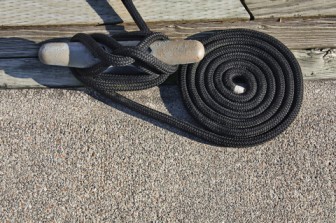| Here's a guideline for the diameter sizes appropriate for different boat sizes: | |
| Length of Boat | Recommended Diameter of Dock Line |
|---|---|
| Up to 27' | 3/8" |
| 28'-31' | 7/16" |
| 32'-36' | 1/2" |
| 37'-45' | 5/8" |
| 46'-54' | 3/4" |
| 55'-63' | 7/8" |
| 64'-72' | 1" |
Don't forget to check the spare dock lines in your boat's locker or lazarette. If you don't use them very often, you might be surprised at how old and stiff your transient dock lines can get just sitting below in the bottom of the lazarette. You don't want an unpleasant surprise when you go to use them for the first time in months.
Dock lines should be made of nylon for the best combination of strength and elasticity. Nylon is strong and durable, and because it's "stretchy," it can absorb the shock of the additional load when waves or wakes shove your boat around. Low-stretch lines made of other materials, such as polyester, can break, or loosen or tear out your cleats.
Three-strand dock lines are the most affordable and the easiest to splice. Double-braid lines are somewhat stronger than three-strand, but have less stretch.
Your bow and stern lines should be about two-thirds the length of your boat. Spring lines should be about as long as the boat itself. The diameter of the line needs to be larger for larger boats. For smaller boats, a smaller diameter line can be used, but don't go below about 3/8", because the line becomes harder to handle and hold onto, and very small diameter lines will stretch too much and wear out earlier.

Leave a Reply
You must be logged in to post a comment.